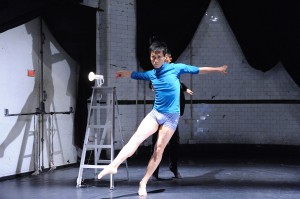
There are no fixed scripts for actors to follow, which means they have to improvise a lot. Actress Gloria Poon Yuen-mai says, “The audience will always surprise you in a site-specific drama, I think that is very exciting.” Yet she also finds it very difficult not to get distracted by the people around her.
As for the audience members, they can find themselves deeply drawn into the world of the drama. Dianty Ho Yuen-yee, is a hardcore fan of site-specific drama and has watched one particular show seven times. “I can get myself totally immersed in the story. It’s like I am one of the characters in the drama. That is very interesting and fresh to me.” Ho says.
Apart from theatre, there are also dance performances taking place away from the stage.
Kom Tong Hall in Mid-Levels is a colonial three-story mansion built in a classical style popular during Edwardian Hong Kong. Today it is the home of the Dr. Sun Yat-sen Museum, but it is also the unlikely venue for a contemporary dance performance.
The dancers begin their performance along the veranda, between several Greek-style granite columns. Following the saxophone melodies of the popular 1940s mandarin song, “Rose, Rose, I Love You”, the performers and the audience continue on to the foyer of the hall. As the vantage point of the audience changes, a vivid story is to be unfolded.
Choreographer of the Dance Art Performing Group, Francis Leung Ka-kuen picked the historical Kom Tong Hall to stage his new work, Shattered Shackles, because he believes the location can symbolise some of its themes. The work is based on the two stories, Crystal Boys and Love’s Lone Flower,by the Taiwanese writer, Pai Hsien-yung.
“We hope to unveil taboos in this performance, like the homosexuals and sex workers shunned by the traditional Chinese society.” Leung says.
“The Kom Tong Hall has historical architecture; I use it to symbolize the traditional shackles constituted by different levels of societal norms.”
Throughout the performance, the audience can flow freely from one place to another as the scene changes.
Leung’s colleague, Andy Wong Ting-lam, is both a choreographer and a dancer. Wong agrees with Leung about the importance of the location. He says dancers in site-specific performances have to be more sensitive to the environment. “We have to research and explore the location first, such as studying the texture of the ground, the direction of air flow, the lighting and so on. These things will affect the atmosphere. But these are not things we can learn from our normal dance training,” Wong says.
He adds, “To perform a site-specific dance is to put the language or structure of dance into a particular space, which makes the two elements interact with each other.”
Apart from the performers, Wong believes audience members also enjoy a richer experience s from site-specific dance as well. “The feel of the resonance of the site, the context and the performance would stimulate both the performers and the audience to think,” he says.







































